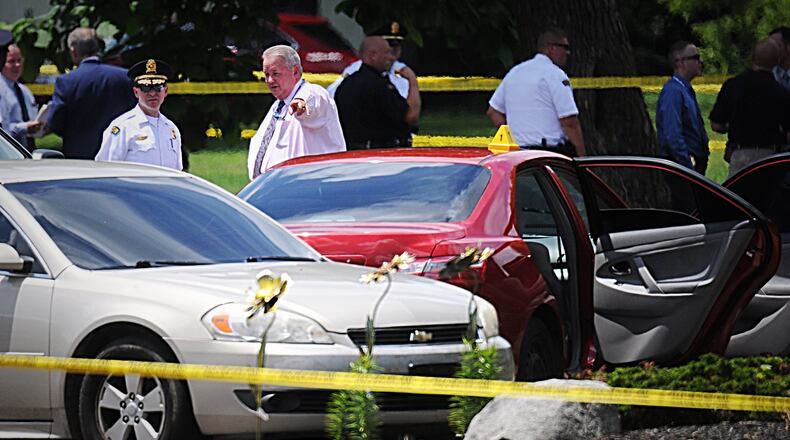“Obviously, there is always concern that firearms may end up in possession of someone who is not legally permitted to have possession of a firearm,” said Sgt. Nathan Dennis with the public affairs unit of the Ohio State Highway Patrol. “The public is encouraged and required to report a lost or stolen firearm to their local law enforcement agency immediately.”
Dayton police officials, however, say the increase in weapon offenses likely reflects increased enforcement actions meant to get guns off the street and out of the hands of dangerous individuals.
Last year, Ohio law enforcement agencies entered 16,520 stolen firearms into the Law Enforcement Automated Data System (LEADS) that is operated by the Ohio State Highway Patrol.
The number of firearms reported stolen was up nearly 13% from 2019, according to state patrol data.
Ohio police agencies aren’t required to enter stolen guns into the system though most do, and some stolen firearm entries may be resubmissions meant to fix errors, officials said.
More guns also were reported missing to the state last year, and Sgt. Dennis said the theft or loss of any deadly weapon is cause for concern.
Authorities can trace firearms to their manufacturer and point of retail sale using their serial number, make and model, and federal firearms licensees are supposed to keep records of purchases and buyers, said Suzanne Dabkowski, a spokesperson with Bureau of Alcohol, Tobacco, Firearms and Explosives’ Columbus Field Division.
But it’s really hard to develop investigative leads about who possessed a firearm that was used in a crime when the guns were stolen, she said.
Unless theft suspects are identified, the forensic chain-of-custody trail often is a dead end.
Dabkowski said the biggest concern about stolen firearms is they will be used for other crimes in the future.
“The person who stole it, whether from a licensed dealer or a private situation, they are going to sell it somebody who can’t have firearms or they are going use it themselves in a crime or trade it for drugs,” Dabkowski said. “There’s just any number of possibilities and none of them are good.”
Stolen firearms often end up on black market.
In November, Dayton police officers saw two vehicles run a red light at the intersection of Wayne and Phillip avenues and turn into the parking lot of police district headquarters, according to a criminal complaint in U.S. District Court for the Southern District of Ohio.
The officers questioned the driver of the second vehicle, which appeared to be chasing the other car, and they say they heard a firearm fall against the driver’s door and land on the floorboard.
Officers detained the driver and found a a 9mm loaded handgun that was reported stolen out of Illinois, the criminal complaint says.
The driver allegedly admitted the handgun was his and that he purchased it “off the streets,” authorities said.
The suspect was prohibited from buying or possessing a firearm because he had been convicted of other felony crimes, including assault with a deadly weapon.
Unlawful possession of a firearm, sometimes called having weapons under disability, is one of the more common offenses ATF investigates. People prohibited from having guns include felons, domestic violence offenders, undocumented aliens and people who were dishonorably discharged.
It’s impossible to know for sure how often stolen guns are used in other crimes. But some studies suggest it could be fairly common.
A survey of state and federal prisoners found that 90% of inmates who possessed a gun during the offense for which they were incarcerated did not obtain it from a retail source, according to a study published in 2019 by the Bureau of Justice Statistics.
About 43% of these prisoners obtained the guns from the street or the underground market, while about 6% had stolen it, according to the survey of prison inmates that was conducted in 2016.
There is no national firearms registry, and this means gun owners should keep records about their firearms in case they are stolen or go missing, Dabkowski said.
Authorities cannot easily figure out a stolen or missing gun’s serial number, make or model unless the owner has recorded that information.
In Dayton, police recorded 704 weapon law violations in the first six months of the year, which is up from 471 during the same period in 2020 and more than double the tally in the first half of 2019, according to department data.
This category of violations includes having a weapon under disability and improper handling of a firearm, officials said.
An increase in weapons violations likely shows that proactive law enforcement activities are getting guns off the street, said Dayton police Major Brian Johns, commander of investigations and administrative service.
“We should feel good about that, because it’s one less gun that can be used to shoot somebody or shoot someone’s house up,” he said.
The police department conducted 17 gun-reduction initiatives (GRIs) between January and June that led to the recovery of 64 firearms, officials said. Dayton has seen reductions in violent crime this year, and Johns said he believes the GRIs played a significant role.
Earlier this year, Dayton police tried to pull over an SUV for having an illegal window tint, but the vehicle fled, according to a criminal complaint in U.S. District court.
Police said they pursued the vehicle, which crashed into a parked construction truck and the driver ran into the woods, the complaint states.
Police said they captured the suspect and retraced his steps and found a 9mm pistol that was reported stolen out of Brown County, the complaint says.
The driver denied the gun was his but lab tests allegedly showed his DNA was on the weapon. The suspect previously was convicted of trafficking in heroin.
About the Author




